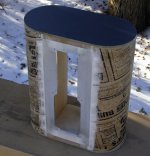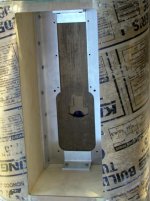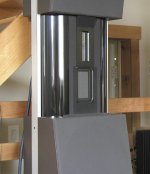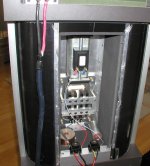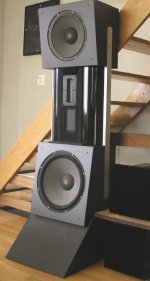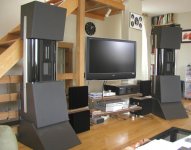454Casull said:
From what I remember, increasing the thickness will also raise resonant frequency, since stiffness goes up with the cube while mass only follows linearly with thickness.
I'd have to look it up to confirm, but i think that adding mass lowers resonance by the square.
dave
BTW.. I will use cheap "eastern" plywood
I dont care if baltic or marine plywood is of better quality - I like "soft wood" for speaker cabinets and as fore the finish, it will be left rough as it is
Like others I think MDF has no soul at all, actually it has been said that the HDF is the worst of all
I dont care if baltic or marine plywood is of better quality - I like "soft wood" for speaker cabinets and as fore the finish, it will be left rough as it is
Like others I think MDF has no soul at all, actually it has been said that the HDF is the worst of all
Re: Re: building with real wood
I knew if I waited long enough, you'd come around.
"As everybody knows high power amplifiers use larger electrons to achieve this high power. The bigger electrons don't start or stop as fast as normal electrons resulting in much heavier, less nimble watts.
So high power amplifiers can never have the finesse of low power amplifiers. High sensitivity speakers only work with the smaller electrons (the smallest are produced by tube amplifiers).
Thus if you use a high power amplifier with sensitive speakers you need a transformer that slims down the electrons and makes them
swifter. Such transformers are available from Jenny Craig Audio Inc., Phen-Fenophile Corp. and the US Nuclear Agency."
Alan Ross
PS. Don't forget to elevate the amplifiers above the speakers, so the signal can flow easier.
cheers Cal
Cal Weldon said:
Wait... did Cal and Chris just agree on something audio? Uh-oh.
I knew if I waited long enough, you'd come around.
Jumbo sized bass electons need jumbo wire, you know that.
"As everybody knows high power amplifiers use larger electrons to achieve this high power. The bigger electrons don't start or stop as fast as normal electrons resulting in much heavier, less nimble watts.
So high power amplifiers can never have the finesse of low power amplifiers. High sensitivity speakers only work with the smaller electrons (the smallest are produced by tube amplifiers).
Thus if you use a high power amplifier with sensitive speakers you need a transformer that slims down the electrons and makes them
swifter. Such transformers are available from Jenny Craig Audio Inc., Phen-Fenophile Corp. and the US Nuclear Agency."
Alan Ross
PS. Don't forget to elevate the amplifiers above the speakers, so the signal can flow easier.
cheers Cal
"As everybody knows high power amplifiers use larger electrons to achieve this high power. The bigger electrons don't start or stop as fast as normal electrons resulting in much heavier, less nimble watts.
So high power amplifiers can never have the finesse of low power amplifiers. High sensitivity speakers only work with the smaller electrons (the smallest are produced by tube amplifiers).
Thus if you use a high power amplifier with sensitive speakers you need a transformer that slims down the electrons and makes them swifter.
Such transformers are available from Jenny Craig Audio Inc., Phen-Fenophile Corp. and the US Nuclear Agency."
Now that's what I call science, or marketing for Electroworld super market
Cheers
Peter
Why didn't someone let me know this was going on?...Like around post #65? 
From ScottMOOSE:
I'm cutting 3/4" mdf now. I have the cement board and #420 acoustic panels at hand. Please suggest any options I have to overcome energy storage. Cross-bracing?
From ScottMOOSE:
Either that, or line the regular 3/4in material with at least 1/4in of concrete board, as Bob Brines does with his MLTLs. That works, but you then run into other problems such as energy storage.
I'm cutting 3/4" mdf now. I have the cement board and #420 acoustic panels at hand. Please suggest any options I have to overcome energy storage. Cross-bracing?
In that case resonant frequency would be linearly proportional to thickness.planet10 said:
I'd have to look it up to confirm, but i think that adding mass lowers resonance by the square.
dave
The complete speaker also contains two woofers (12 and 15" Focal Audioms) in folded baffle setup. The boxes are made of dual layer 3/4" MDF, plastic laminate on the outside. Both sections are attached together with 0.75 x 1.5" aluminum bars. Bottom stand is also filled with sand. The whole thing is modular and easy to transport.
Attachments
Scottmoose said:
MDF cabinets attempt a similar thing, but being far less massive need to be much thicker, obviously. Much thicker than most people realise -although it's dense, MDF isn't very stiff at all. For a typical FR driver application, you really need about 1 1/4in thick panels minimum to push panel resonance down into a place where it doesn't do any damage. Either that, or line the regular 3/4in material with at least 1/4in of concrete board, as Bob Brines does with his MLTLs. That works, but you then run into other problems such as energy storage. If you can't go to something with the density and stiffness-weight ratio of steel, better to push them up, out of the way, IMO.
OK, since everyone says there is such a hugh difference in materials, here's what I will do:
I will build three boxes, of three different materials - one of MDF, one from baltic birch plywood, and the third from cheap spruce sheathing. I will construct each box from the same thickness material (1/2"). I will build each the same way - with glue and 1.5" airgun nails. They will be identical in every way. I will make one hole for a midbass driver that has a normal Xmas~5mm.
I will then test each box for panel resonance, using nearfield frequency response with the mic 1/2" from the largest panel.
There will be no damping material, the boxes will be empty sealed boxes.
Has someone already done this and published the results?
planet10 said:
In a box like the Fonken the largest unbraced panel is just over 4" -- sometimes they will get out to as much as 6-8". The bracing doesn't need to be a matrix you just have to orient it correctly (ie the ubiquitous shelf brace is one of the least effective.
Air space damping, no panel damping. That just takes you in the wrong direction. Lower panel resonance, greater energy storage, & lower panel resonance Q.
The box doesn't suck it out, it buries it in the low level noise prodcued by the cabinet.
Doesn't an undamped box add it's own colouration?
454Casull posted:
I think there's an inverse relationship in there....
For my own piece of mind (I'm not going to build 3 prototypes) I will add 3/4" dowels across the interior of the case. They'll be spaced with some influence allowed to ratio's of 1.618...
In that case resonant frequency would be linearly proportional to thickness.
I think there's an inverse relationship in there....

For my own piece of mind (I'm not going to build 3 prototypes) I will add 3/4" dowels across the interior of the case. They'll be spaced with some influence allowed to ratio's of 1.618...
MJL21193 said:Doesn't an undamped box add it's own colouration?
The boxes are damped, the panels only the inherent damping in the plywood.
All panels add colouration. The idea is to minimize them.
dave
Ed Lafontaine said:For my own piece of mind (I'm not going to build 3 prototypes) I will add 3/4" dowels across the interior of the case. They'll be spaced with some influence allowed to ratio's of 1.618...
Ed,
What box are you building? Holey brace(s) are a lot more effective than dowels.
dave
Hi Dave,
The box will closely resemble this:
The box dimensions will be 39" h x 7.5" wide x 14" d. It is an effort to get as much out of an RS180 pair as they have to offer. I think the dowels should be connecting the side panels.
The box will closely resemble this:
An externally hosted image should be here but it was not working when we last tested it.
The box dimensions will be 39" h x 7.5" wide x 14" d. It is an effort to get as much out of an RS180 pair as they have to offer. I think the dowels should be connecting the side panels.
- Status
- This old topic is closed. If you want to reopen this topic, contact a moderator using the "Report Post" button.
- Home
- Design & Build
- Construction Tips
- Discussion on what materials to build speakers out of
